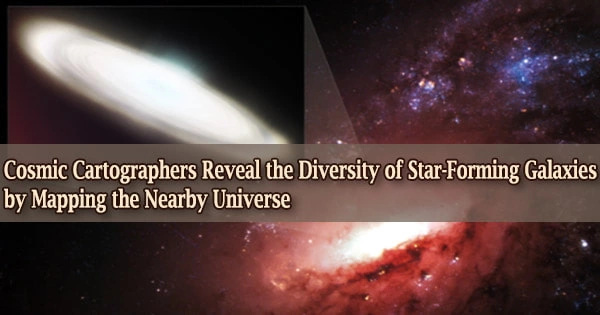The first census of molecular clouds in the surrounding Universe has been conducted by a team of astronomers utilizing the Atacama Large Millimeter/submillimeter Array (ALMA), indicating that, contrary to previous scientific consensus, these stellar nurseries do not all appear and act the same.
They’re just like the individuals, houses, neighborhoods, and regions that make up our own world. Long ocean trips, adventurers plunging into jungles, and traders uncovering new links between continents are all images that many people associate with the name “explorers.”
Exploring as a vocation became outdated as there were no big, unknown places left to explore, and the Earth had been extensively mapped out. Stars are born from molecular clouds, or stellar nurseries, which are clouds of dust and gas. During the lifespan of a stellar nursery, thousands or even tens of thousands of young stars can be formed.
There are, nevertheless, many unexplored locations beyond our globe. Hundreds of modern-day explorers are currently mapping out the galaxies that surround us, a process we call Cosmic Cartography.
Fortunately for us, there isn’t as much scurvy and snakes involved, but today’s surveys require a significant amount of effort, and cosmology has its own set of difficulties.
Astronomers working on the PHANGS Physics at High Angular Resolution in Nearby GalaxieS project conducted the first systematic survey of 100,000 stellar nurseries across 90 galaxies in the nearby Universe between 2013 and 2019, in order to better understand how they connect back to their parent galaxies.
“We used to think that all stellar nurseries across every galaxy must look more or less the same, but this survey has revealed that this is not the case, and stellar nurseries change from place to place,” said Adam Leroy, Associate Professor of Astronomy at Ohio State University (OSU), and lead author of the paper presenting the PHANGS ALMA survey.
“This is the first time that we have ever taken millimeter-wave images of many nearby galaxies that have the same sharpness and quality as optical pictures. And while optical pictures show us light from stars, these ground-breaking new images show us the molecular clouds that form those stars.”
The PHANGS project is a new form of cosmic cartography that allows us to see the diversity of galaxies in a new light, literally. We are finally seeing the diversity of star-forming gas across many galaxies and are able to understand how they are changing over time. It was impossible to make these detailed maps before ALMA.
Erik Rosolowsky
These changes were compared to how people, residences, neighborhoods, and cities exhibit similar features yet differ from area to region and country to country.
“To understand how stars form, we need to link the birth of a single star back to its place in the Universe. It’s like linking a person to their home, neighborhood, city, and region. If a galaxy represents a city, then the neighborhood is the spiral arm, the house the star-forming unit, and nearby galaxies are neighboring cities in the region,” said Eva Schinnerer, an astronomer at the Max Planck Institute for Astronomy (MPIA) and principal investigator for the PHANGS collaboration “These observations have taught us that the “neighborhood” has small but pronounced effects on where and how many stars are born.”
The scientists looked for parallels and differences in the molecular gas characteristics and star formation processes of galaxy disks, stellar bars, spiral arms, and galaxy centers to better understand star formation in different types of galaxies. They confirmed that star formation is influenced by the location, or neighborhood.
“By mapping different types of galaxies and the diverse range of environments that exist within galaxies, we are tracing the whole range of conditions under which star-forming clouds of gas live in the present-day Universe. This allows us to measure the impact that many different variables have on the way star formation happens,” said Guillermo Blanc, an astronomer at the Carnegie Institution for Science, and a co-author on the paper.
“How stars form, and how their galaxy affects that process, are fundamental aspects of astrophysics,” said Joseph Pesce, National Science Foundation’s program officer for NRAO/ALMA.
“The PHANGS project utilizes the exquisite observational power of the ALMA observatory and has provided remarkable insight into the story of star formation in a new and different way.”
Annie Hughes, an astronomer at L’Institut de Recherche en Astrophysique et Planétologie (IRAP), added that this is the first time scientists have a snapshot of what star-forming clouds are really like across such a broad range of different galaxies.
“We found that the properties of star-forming clouds depend on where they are located: clouds in the dense central regions of galaxies tend to be more massive, denser, and more turbulent than clouds that reside in the quiet outskirts of a galaxy. The lifecycle of clouds also depends on their environment. How fast a cloud forms stars and the process that ultimately destroys the cloud both seem to depend on where the cloud lives.”
This isn’t the first time ALMA has detected star nurseries in distant galaxies, but nearly all previous investigations focused on single galaxies or parts of galaxies. PHANGS gathered a complete picture of the local population of galaxies over a five-year period.
“The PHANGS project is a new form of cosmic cartography that allows us to see the diversity of galaxies in a new light, literally. We are finally seeing the diversity of star-forming gas across many galaxies and are able to understand how they are changing over time. It was impossible to make these detailed maps before ALMA,” said Erik Rosolowsky, Associate Professor of Physics at the University of Alberta, and a co-author on the research.
“This new atlas contains 90 of the best maps ever made that reveal where the next generation of stars is going to form.”
The new atlas does not signal the end of the team’s journey. While the survey provided answers to what and where, it also prompted new ones.
“This is the first time we have gotten a clear view of the population of stellar nurseries across the whole nearby Universe. In that sense, it’s a big step towards understanding where we come from,” said Leroy.
“While we now know that stellar nurseries vary from place to place, we still do not know why or how these variations affect the stars and planets formed. These are questions that we hope to answer in the near future.”
The results of the PHANGS survey are detailed in ten articles delivered this week at the American Astronomical Society’s 238th meeting.
















